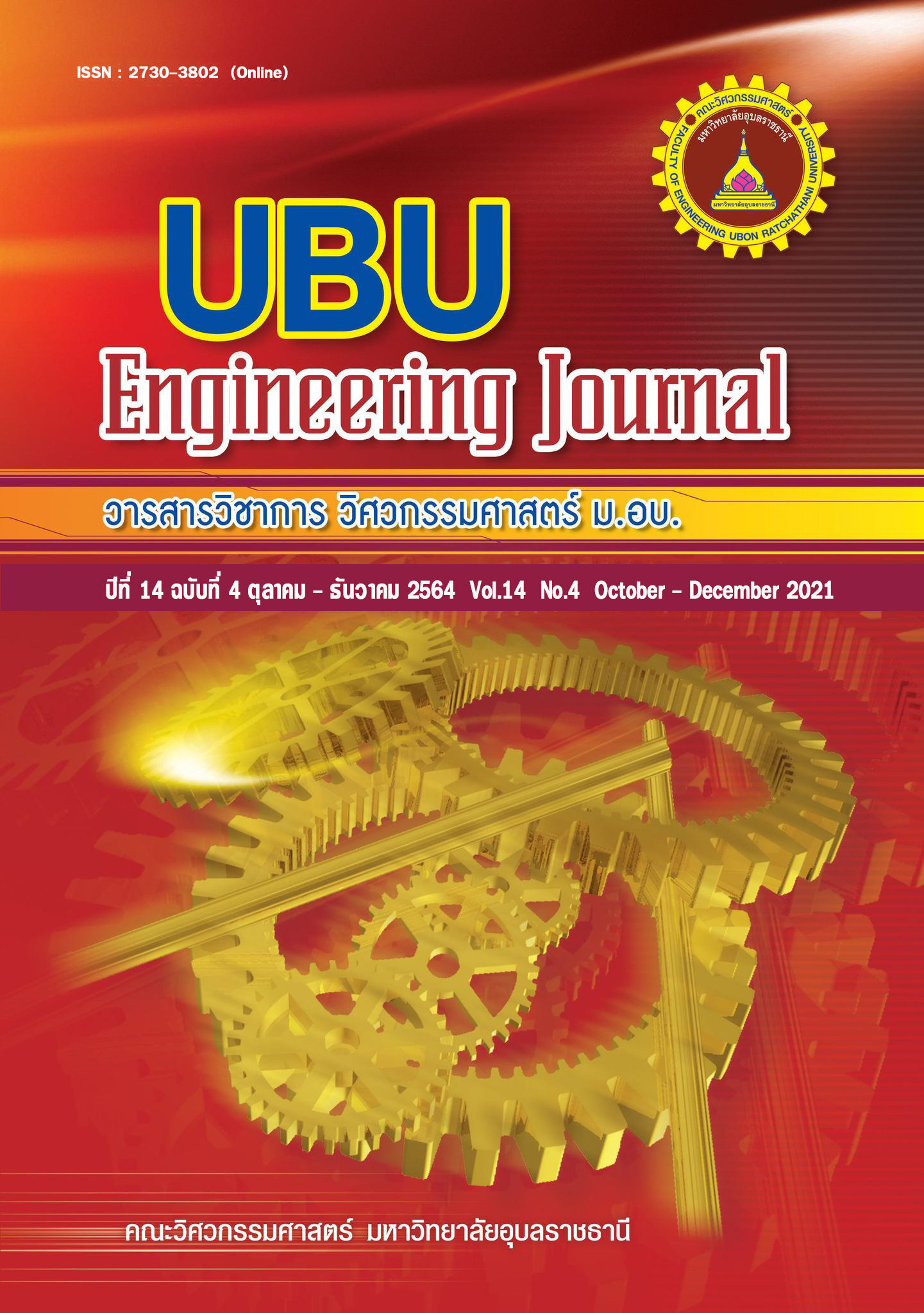A Comparative of Permanent Deformation of Asphalt Concrete Mixed with AC 60-70 and Polymer Modified Asphalt Binder
Main Article Content
Abstract
Nowadays, the increasing amount of traffic on the road can result in more repeating loading and is a cause of the pavement distresses. The surface distresses caused by the repeated load produce permanent deformation of surface pavements. The test for engineering property on asphalt concrete for finding the permanent deformation can be processed by doing the dynamic creep test in the repeating loading manner. The present study then compared the permanent deformation and the accumulating strain of asphalt concrete mixed with the AC 60-70 binder and polymer modified asphalt binder with limestone which consisted of two types namely Upper Limit gradation and Lower Limit gradation by testing the asphalt concrete at the temperature 40ºC. The results showed that the resistance of the permanent deformation of asphalt concrete was depended on the type of asphalt binder and the gradation of aggregate. Then, the asphalt binder mixed with the polymer modified asphalt binder had higher permanent deformation resistance than asphalt concrete mixed with the AC 60-70 binder. Finally, the specimen with Upper Limit gradation had higher permanent deformation resistance than Lower Limit gradation.
Article Details
References
ศูนย์เทคโนโลยีสารสนเทศและการสื่อสาร. Length of Road Network in Thailand 2009 to 2020. สำนักงานปลัดกระทรวงคมนาคม, กระทรวงคมนาคม. 2020.
วัชรินทร์ วิทยกุล. เทคโนโลยียางมะตอย.สำนักพิมพ์มหาวิทยาลัยเกษตรศาสตร์. 2003, 253-255.
สำนักวิเคราะห์และตรวจสอบ, สำนักบริหารบำรุงทาง. คู่มือตรวจสอบและประเมินสภาพความเสียหายของผิวทาง. กรมทางหลวง ประเทศไทย. 2007.
Fwa Tien F, Tan Siew A, Zhu L. Y. Rutting prediction of asphalt pavement layer using c– u model. Journal of Transport Engineering. 2004, 130(5):675–683.
Sureyya T, Halit O, Atakan A. Investigation of rutting performance of asphalt mixtures containing polymer modifiers. Construction and Building Materials. 2007, 21(2): 328-337.
Dong Z, Xiaoming H, Yongli Z. Algorithms for generating three-dimensional aggregates and asphalt mixture samples by the discrete-element method. Journal of Materials in Civil Engineering. 2012, 27: 111–117.
Tao X, Xiaoming H. Investigation into causes of in-place rutting in asphalt pavement. Construction and Building Materials. 2012, 28: 525-530.
Jiupeng Z, Jianzhong P, Zengping Z. Development and Validation of Viscoelastic-Damage Model for Three-Phase Permanent Deformation of Dense Asphalt Mixture. Journal of Materials in Civil Engineering. 2013, 24(7): 842-850.
Jacob U, Mordechai P. (1985). “A comprehensive viscoelasto-plastic characterization of sand-asphalt compressive and tensile cyclic loading. Journal of Test and Evaluation. 1985, 13(1): 49–56
Zhi S, Wing Gun W. Nonlinear properties analysis on rutting behaviour of bituminous materials with different air void contents. Construction and Building Materials. 2009, 23: 3492-3498
Amy L S. Characterization of transverse profile. Transportation Research Record: Journal of the Transportation Research Board. 199, 1655: 185–191.
Safwan A. K, Tamer M. B. Rutting parameters for asphalt concrete for different aggregate structures. International Journal of Pavement Engineering. 2011, 12(1): 13–23.
Xiaoming H, Yuqing Z. A new creep test method for asphalt mixtures. Road Materials and Pavement Design. 2010, 11(4): 969–991.
Quantao L, Alvaro G, Erik S, Martin van de V. Induction healing of asphalt mastic and porous asphalt concrete. Construction and Building Materials. 2011, 25: 3746–3752.
Alvaro G, Erik S, Martin van de V, Gerbert van B. Optimization of composition and mixing process of a self-healing porous asphalt, Construction and Building Materials. 2012, 30: 3746–3752.
María del Carmen R, Fernando M, María Jose Martínez-E, German M, Jose Miguel V. Comparative analysis of emissions from the manufacture and use of hot and half-warm mix asphalt, Journal of Cleaner Production. 2013, 41: 1–6.
Miguel Perez-M, Fernando Moreno-N, Jesus Martín-M, Carolina Ríos-L, Ma Carmen Rubio-G. Analysis of cleaner technologies based on waxes and surfactant additives in road construction, Journal of Cleaner Production. 2014, 65: 374-379.
Fernando MORENO-N, Guillermo Iglesias S, M.C. Rubio-G, Development of mechanomutable asphalt binders for the construction of smart pavements, Materials and Design. 2015, 84: 100–109.
Jiwang J, Fujian N, Lei G, Shenxin L. Developing an optional multiple repeated load test to evaluate permanent deformation of asphalt mixtures based on axle load spectrum. Construction and Building Materials. 2016, 122: 254-263.
Yaofei L, Ke Z, Peilong L, Jianhua Y, Xiangbing X. Performance evaluation of stone mastic asphalt mixture with different high viscosity modified asphalt based on laboratory tests. Construction and Building Materials. 2019, 225: 214-222.
Lidija R, Mojca Ravnikar T, Marjan T. Increasing the rate of reclaimed asphalt in asphalt mixture by using alternative rejuvenator produced by tire pyrolysis. Construction and Building Materials. 2020, 232: 117117.
Matthew W. W, Kamil K, Teijo P, Karim El-B, Simple Performance Test for Superpave Mix Design, Transportation Research Board, Washington. DC, 2002.
Taher Baghaee M, Mehrtash S, Mohamed Rehan K, Experimental characterization of rutting performance of Polyethylene Terephthalate modified asphalt mixtures under static and dynamic loads, Construction and Building Materials. 2020, 65: 487–494.
K.E. Kaloush, M.W. Witczak, Tertiary flow characteristics of asphalt mixtures, Journal of the Association of Asphalt Paving Technologists. 2002, 71: 248–280.
Thomas H, John D'A, John B. Superpave Asphalt Mixture Design Workshop. U.S. Department of Transportation Federal Highway Administration. 2002.
FILIPPO M, Fiber/Polymeric compound for high modulus Polymer Modified Asphalt (PMA). Social and Behavioral Sciences. 2013, 104: 39–48.
Jian-Shiuh C, Ta Jung W, Cheng-Te L, Evaluation of a highly-modified asphalt binder for field performance. Construction and Building Materials. 2018, 171: 539–545.
ประสิทธิ์ ภู่ประทุม. อุณหภูมิมาตรฐานของถนนกรมทางหลวง.รายงานฉบับที่ วพ.158 ศูนย์วิจัยและพัฒนางานทาง กรมทางหลวง, กระทรวงคมนาคม. 1996.
ปนัดดา กสิกิจวิวัฒน์, กฤษณะ จันทรโชติ. ระยะเวลาที่เหมาะสมของการบ่มตัวอย่างแอสฟัลต์คอนกรีตในห้องปฏิบัติจากการออกแบบโดยวิธีซูเปอร์เพฟ. วารสารวิชาการพระจอมเกล้าพระนครเหนือ.2020, DOI: 10.14416/j.kmutnb.2020.09.001.
กฤษณะ จันทรโชติ. การศึกษาเปรียบเทียบคุณสมบัติทางวิศวกรรมของแอสฟัลต์คอนกรีตระหว่างวัสดุมวลรวมแบบข้อกำหนดขอบบนและขอบล่างที่ผสมกับแอสฟัลต์ซีเมนต์.วิศวกรรมสาร มก. 2016, 11-22.

